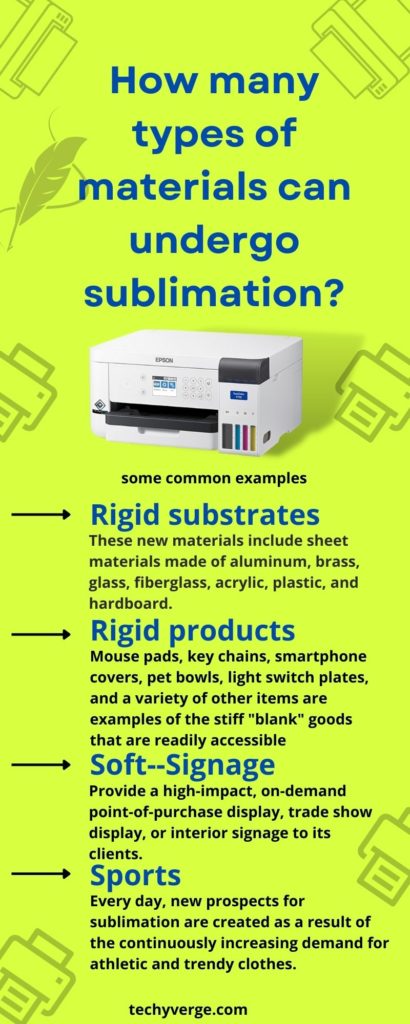Dye Sublimation Printing on Plastics: Unveiling the Art of Polished and Expert Appearance. Dye sublimation printing on plastics is an incredibly effective method for companies seeking to create items that exude professionalism and refinement.
This innovative process, while not overly complicated, yields unparalleled results when applied to polymer-coated substrates and light-colored or white polyester materials.
As the demand for vibrant and long-lasting printed products continues to soar, many find themselves pondering the possibility of dye sublimation printing on plastics. Well, wonder no more—the answer is a resounding “yes.”
Why Is the Printing Process Called Dye Sublimation?
Printing using dye-sublimation requires heating the sublimation ink to a high temperature, often around 400 degrees Fahrenheit.
As a consequence, the ink transforms from a liquid into a gas, at which point it can penetrate the pores of the material being printed on. As soon as the object is withdrawn from the ink, the pores begin to cool and subsequently shut.
This leaves the ink and the image encapsulated on the object’s surface. This method yields an application that is both smooth and long-lasting.
The object’s chemical composition, often known as a polymeric chemical structure, is essential in producing high-quality prints.
Additionally, it must be able to endure the high temperatures that are generated during the printing process. This might challenge materials like plastic, leather, wood, or glass.
Is it Possible to Dye Sublimated Print on Plastic?
Almost anything that has the right chemical composition, that is, that is built from polymers (has a chemical structure that is polymeric), may be printed.
More Information for You: Can we do sublimation on the cork board?
If your substrate, regardless of whether it is leather, wood, glass, or non-polymeric plastic, will retain a clear or white base coat spray throughout the entire process of sublimation printing, then the answer is yes, you can print plastic with dye-sub printing; however, there is a significant catch to this.
Heat is required for the dye sub-print process. A great deal of heat. Roughly four hundred degrees Fahrenheit of heat, give or take a few degrees.
Because plastic has the propensity to melt when heated to that degree, heat and plastic may be a dangerous mix.
Therefore, it is possible to print on certain plastics; however, to do so, the polymers must first be strengthened with fiberglass.
When this article was written, I was unaware of any formed polymers capable of being printed. FR polymers that are flat and unreinforced. They can be trimmed to fit any profile.
I’m also going to expand my response to cover other aspects that you didn’t directly ask about since I like writing about dye sublimation printing and because inquiring minds want to know.
How to Sublimate Plastic Mugs – Plastic Mug Printing?
How Many Types of Materials Can Undergo Sublimation?

Does dye sublimation work on all materials?
The following is a list of some of the material options that are available to you when you use dye-sublimation:
Rigid Substrates
Now that they aren’t restricted to fabric substrates, there is a vast array of variations in the products that can be promoted and how they may be promoted.
New polymer-treated materials, designed particularly for dye-sublimation applications, have recently been created. These new materials include sheet materials made of aluminum, brass, glass, fiberglass, acrylic, plastic, and hardboard.
Rigid Products
Mouse pads, key chains, smartphone covers, pet bowls, light switch plates, and other items are stiff “blank” goods that are readily accessible.
These may be sublimated with relative ease and are wonderful additions to the selection of custom-branded merchandise that your company can provide to its customers.
Soft-Signage
Provide a high-impact, on-demand point-of-purchase display, trade show display, or interior signage to its clients. Sublimation is a fast and effective process ideal for promotions with a short turnaround time.
Fabrics
You have your pick from a variety of fabrics that are made entirely of polyester. There are two main kinds of textiles available to choose from:
- Texture woven in banner stands, outside banners, outdoor signs, and upholstery must be durable and long-lasting.
- Custom clothes, indoor flags and banners, photographic backgrounds, and table coverings may benefit from this knit material since it drapes and flows more naturally.
Sports and Fashion Apparel
It is possible to have your brand printed on everything from t-shirts and cycling jerseys to purses and baseball hats. New sublimation prospects are created daily due to the continuously increasing demand for athletic and trendy clothes.
Photo Printing
From customized gift products like magnets, wall mounts, and photo clothing to photo backdrops, sublimation is ideal for providing high-quality photographic pictures to various markets. These images may be printed on photo backdrops.
Ceramic Tiles
Interior designers and decorators may produce individualized ceramic tiles in kitchens, bathrooms, foyers, museums, restaurants, and workplaces. These tiles can also be used for other applications.
All of the materials available as product “blanks” for rapid heat transfer are polymers that are either suited for heat transfer or may be used for heat transfer.
In addition, the user has access to various pre-treatment choices, making it possible to print on various goods.
Final Verdict
Dye-sublimation printing on plastics is possible; it can be tricky. The key to success is finding the right type of plastic and ensuring that it is properly prepared before printing. You can produce beautiful results that will last for years with the right precautions.
- Can You Sublimate on Nylon and Polyester? Which oneis the Best - February 19, 2024
- Converted Epson Eco Tank Et-2800 Vs Et-2803 Sublimation Printer [Review 2024] - February 19, 2024
- Can You Reuse Sublimation Prints? (The Righ Answer) - February 19, 2024




![Top 100+ FAQs Related to Sublimation Printing & Heat Press [Updated 2024] faqs related to sublimation Printing](https://www.techyverge.com/wp-content/uploads/2022/08/faqs-related-to-sublimation-Printing--150x150.jpg)

